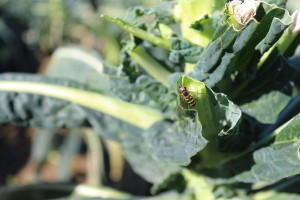Insects are vital to the maintenance of a vibrant, diverse ecology and contribute to soil and crop health. Yet, due to habitat loss, invasive species, and pesticide use, invertebrate populations are in sharp decline. Solutions to the situation are being sought through the ways in which farmers and private landowners manage their lands. Because crop health is strongly linked to surrounding landscapes via the ongoing flow of organisms, farming with conservation techniques can be a win-win proposition, one that enhances ecological health and farm production.
On November 9, the Hudson Valley Farm Hub and the Xerces Society hosted an all-day workshop on the benefits of biodiversity-conscious farm management. The event attracted farmers, agricultural employees, natural resource specialists, and land managers – all eager to learn the ins and outs of a technique called conservation biological control.
“As the single largest land use on earth, farming is critical to the future of biodiversity, and biodiversity is critical to the future of farming,” says Kelly Gill, a pollinator conservation specialist at the Xerces Society and one of the workshop’s featured speakers.
According to Gill, the number of invertebrates that could be beneficial to farming is immense. Each of these insects has a particular effect on variables like soil health. Ground beetles, for instance, can consume almost any type of insect and eat their weight in prey over the course of a day. Flower flies are important pollinators and can consume up to 50 aphids per day. This list also includes insects like minute pirate bugs that excel in finding prey at low densities and predatory stink bugs that can target over 100 insect species.
The contributions these insects make to pest management have largely been overlooked since the advent of chemical pesticides. However, many farmers are now looking at how they can directly impact insect populations through conservation techniques. These include practices such as creating landscapes that nurture natural pest predators while reducing conditions favorable to pests, and adopting Integrated Pest Management (IPM) practices to minimize the use of pesticides that can be harmful to beneficial organisms.
Because pests thrive in monoculture environments, the solution to the problem is often to increase landscape complexity. Farmland interspersed with wild areas, for instance, will provide the habitat that beneficial insects need to complete their lifecycle. Other conservation practices include planting native plant field borders, establishing hedgerows of flowering shrubs and small trees, establishing “beetle banks” (strips planted with grasses within a crop field) to provide shelter for beneficial insects, and planting cover crops on fallow fields.

Farmers and land managers deal with competing priorities, so the specific methods they choose to adopt will always reflect a balancing of ecological and financial considerations. Yet, while many of these methods require initial investment, the value of increased pollination and pest control through improved crop yields means that they are likely to pay for themselves over time.
One of the steps that farmers and land managers can take is to survey their property and see what beneficial insects and animals are already present, and then explore conservation techniques that are likely to boost these populations. This year, the Farm Hub partnered with the Hawthorne Valley Farmscape Ecology Program to begin standardized monitoring for beneficial organisms. This monitoring will be expanded to additional fields and invertebrates over the upcoming season, and will include techniques such as field surveys, vegetation mapping, and the installation of trap counts and remote sensing monitors for select insects. The goal is to understand how the management practices adopted at the Farm Hub are impacting insect communities, and with time, to determine what that means for other Hudson Valley farmers seeking to adopt management techniques that improve biodiversity on their farms and surrounding landscapes.
For more resources on biodiversity conservation, visit the Xerces Society website.
Presenters at the workshop included Kelly Gill of the Xerces Society, Jean-Paul Courtens of the Hudson Valley Farm Hub, Crystal Stewart of the Cornell University Cooperative Extension Eastern NY Commercial Horticulture Program, Conrad Vispo, PhD, and Claudia Knab-Vispo, PhD, of the Hawthorne Farmscape Ecology Program, and Elizabeth Marks of the USDA’s Natural Resource Conservation Program.
